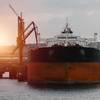Deep Sea Carriers Attracted to Intra-Asia Routes: Analysis
Cargo growth on intra-Asia routes is attracting deep-sea carriers due to the availability of cheap charter vessels and economies of scale between China and SE Asia, but regional players also know how to form defensive alliances, reports Drewry Maritime Research in its latest 'Container Insight Weekly'.
Financially troubled deep-sea ocean carriers are increasingly seeking salvation in the intra-Asia market due to higher than usual cargo growth and the availability of cheap vessel charter rates. Seldom does a month pass without the announcement of at least one new regional service, some of which now deploy vessels over 4,000 teu.
Recent examples include:
- Maersk-owned MCC Transport/NYK’s weekly Japan-China-Thailand schedule calling at Tokyo, Yokohama, Nagoya, Kobe, Hong Kong, Shekou, Laem Chabang, Xiamen and Tokyo. Launched at the end of March, it deploys three 5,000 teu vessels.
- NYK/K Line/Hapag-Lloyd’s Japan-SE Asia service calling at Tokyo, Yokohama, Nagoya, Kobe, Singapore, Jakarta, Singapore, Ho Chi Minh City and Tokyo, which deploys four 4,200 teu vessels.
- Cosco joining PIL/Yang Ming/Wan Hai’s service calling at Xingang, Dalian, Shanghai, Fuzhou, Hong King, Singapore, Port Klang, Penang, Singapore, Hong Kong and Xingang. The service deploys four vessels averaging 4,300 teu.
There is money to be made out of such services, as evidenced by Wan Hai’s financial performance since 2009. Last month the intra-Asia specialist reported yet another set of impressive financial results for 1Q14, and has consistently outperformed many of its peers since 2009 in terms of extracting operating profit out of every dollar earned (i.e. return on sales), despite not having their economies of scale. And OOCL, the next best declared performer after Maersk and CMA CGM, captured 53% of its total traffic from the intra-Asia market in 1Q14.
The intra-Asia market, including Asia/Australia, was also OOCL’s fastest growing in 1Q14, increasing by 14.5% compared to the same period of 2013, up to 723,000 teu, compared to just 3% for all other traffic.
Unlike many of its peers, most of the Wan Hai’s services are focused on intra-Asia routes. Instead of mainly competing with global players on East-West routes, it has generally preferred to seek shelter in intra-Asia trade lanes.
Measuring the way that intra-Asia routes have been growing is difficult, as there are many different trade lanes, and no centralised data source. Moreover, there are many routes served by shuttle services deploying vessels no bigger than 500 teu because of draught restrictions. There is also much trade within countries, such as China (although this is protected for Chinese flag vessels), as well as between countries, and deep-sea transhipment cargo. Maersk’s recently introduced SE Asia/China service deploying three vessels over 4,000 teu, calling at Xingang, Qingdao, Ningbo, Hong Kong, Tanjung Pelepas, Singapore and Xingang, is a good example of the latter.
According to the Intra Asia Discussion Agreement (IADA), its member lines alone shipped 7.2 million teu on the routes shown [pictured here] in 2013, 9% more than in 2012. To put this in perspective, that is more cargo than was shipped between Europe and the whole of North America in 2013 (6.7 million teu), and over double its annual growth rate of 4.3%. IADA members include 11 of the top global deep-sea carriers (but excluding MSC and the three big Japanese lines), as well as a number of regional specialists.
Another 6.2 million teu were shipped in 2013 by all carriers (including IADA members) between China and South Korea, and between China and Japan (the two highest volume trade lanes within the intra-Asian market), where trade growth was a more subdued 1.5% due partly to Japan’s 25% currency devaluation in 2013.
The intra-Asia market is clearly competitive, as evidenced by the forced withdrawal of Swee Joo, Yanghai Shipping, Grand China Shipping, STX Pan Ocean and Hainan PO Shipping since the beginning of 2012. But, whereas many of the vessels operated by these intra-Asia fatalities were below 1,000 teu, and the same still applies to remaining small players today, Wan Hai currently deploys 72 vessels averaging 2,400 teu, ranging between 640 teu and 5,500 teu, which explains why deep-sea carriers are now interested in the market, spurred on by the ready availability of cheap charter vessels.
Not surprisingly, say Drewry, regional players are joining forces to compete more effectively against the incursions of bigger players, to try to limit further capacity growth in certain key trades. Last month Sinotrans, Pan Asia Shipping (intra-Asian arm of Coscon), and Shanghai Puhai Shipping (intra-Asian arm of CSCL) formed an operating alliance on services run between China and Japan. And China’s SITC Container Lines and Shanghai Hai Hua Shipping (Hasco) have agreed to work more closely together between China and Japan.
What this means for future freight rate levels remains to be seen, but there is much ground to recover already. Although 2013 was a difficult year for most carriers, many North-South services have been full since April, which has helped to increase rates. Northbound cargo growth of 12.5% from SE Asia to China in 1Q14 (y-o-y), was a particularly strong driver in this respect. A more detailed analysis of the intra-Asia container market will form part of the Drewry Container Forecaster 3Q14, due to be published in September.
Drewry's View
Deep-sea ocean carriers will continue to use cheap charter rates to become further established in the intra-Asian market, and then use their own tonnage afterwards to squeeze out smaller competitors on routes where vessels over 2,000 teu can be safely deployed. Strong cargo growth is helping carriers to improve freight rates at the moment, but the supply/demand balance is fragile.
Source: Drewry Maritime Research












